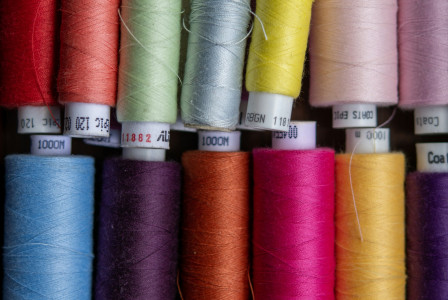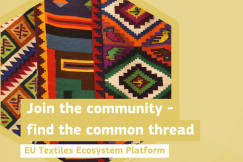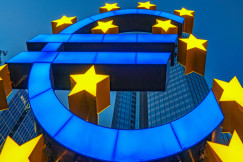Library and support resources
11 September 2025
The EIT KICs Position Paper for a Circular and Sustainable Fashion and Textiles Industry in Europe
Library and support resources
11 September 2025
Ecosystem's readiness to support EU strategic autonomy and defence efforts
Infrastructure
Investments and funding
+21 more
Login / create an account to be able to react
-
89

The EIT KICs Position Paper for a Circular and Sustainable Fashion and Textiles Industry in Europe presents a targeted innovation agenda to drive systemic change and circularity across the European textiles sector.
EIT Climate-KIC
EIT Culture & Creativity
EIT Manufacturing
EURATEX
Federazione Tessile Moda - Sistema Moda Italia
RWTH Aachen University
Topics
Albania
Armenia
Austria
Belgium
Bosnia and Herzegovina
Bulgaria
Croatia
Cyprus
Czechia
Denmark
Estonia
EU-27
Finland
France
Georgia
Germany
Greece
Hungary
Iceland
Ireland
Italy
Kosovo
Latvia
Liechtenstein
Lithuania
Luxembourg
Malta
Moldova
Montenegro
Netherlands
North Macedonia
Norway
Poland
Portugal
Romania
Serbia
Slovakia
Slovenia
Spain
Sweden
Switzerland
Türkiye
Ukraine
Other
Academic / Research and VET Institutions
Business Support Organisation
Company with 250 or more employees
Cluster Organisations
Consumer Organisations
Cultural and Heritage Organisations
Destination Management & Marketing Organisations
EU Institutions
Financial Institutions and Investors
Industry Associations and Chambers of Commerce
International Organisations
Local Authorities
Media / Journalist Organisations
National authorities
Networks and Federations / Confederations
NGOs / Non-profits
Notified Bodies
Regional Authorities
SMEs (a company with less than 250 employees)
Social Economy Entity
Trade Unions
Other
-
Transition Pathway's building blocks
-
-
Ecosystem's readiness to support EU strategic autonomy and defence efforts
-
Infrastructure
-
Investments and funding
-
R&I, techniques and technological solutions
-
Skills
-
Social dimension
-
Sustainable competitiveness
-
Regulation and public governance
-
-
Industrial ecosystems
-
-
Cultural and creative industries
-
Digital
-
Energy-renewables
-
Retail
-
Textile
-
-
Textiles ecosystem areas
-
-
Fibres, yarns and fabrics
-
Apparel and clothing accessories
-
Household/interior textiles
-
Technical textiles
-
Leather and fur
-
Footwear
-
Research and Innovation
-
Technology and Machinery
-
Waste management, reuse and repair
-
Business support and Communication
-
Not area specific (interested in more than one of the above)
-
Share
Strategic Vision
By 2030, the involved Knowledge and Innovation Communities (KICs) aim for a sustainable, circular, and innovative textiles ecosystem. The agenda recognises that the sector is not only a significant driver of environmental pressures, but is itself confronted by escalating economic, skills, employment, and supply chain challenges. As overconsumption, global competition, and regulatory demands mount, innovation emerges as a central lever to safeguard economic competitiveness, develop a highly skilled workforce, and strengthen the resilience of supply chains in the European textile industry. This position paper was developed through collaboration between EIT Culture & Creativity, EIT Manufacturing, and EIT Climate-KIC, with Climate KIC having transitioned to an independent foundation in 2025 after more than 15 years of receiving funding and strategic guidance as an EIT Knowledge and Innovation Community. Significant expert contributions were also provided by representatives from Federazione Tessile Moda - Sistema Moda Italia and EURATEX (Ing. Mauro Sampellegrini), Institut für Textiltechnik RWTH Aachen University (Dr.-Ing. Jan Vincent Jordan), University of the Arts London (UAL) Innovation Lab (Prof. Kate Goldsworthy and Nadja Ohranovic), the European Fashion Alliance and German Fashion Council (Scott Lipinski), and SUPSI (Silvia Zancarli).
Along the Priority Areas of Transformation, Innovation and Research, Education and Skills, Networks and Accessibility, Mobilisation, and Financial Instruments, the following key actions were suggested:
- Advancing digitalisation and the adoption of advanced technologies—including automation, robotics, and digital tools—to increase resource efficiency, foster new business models, and boost collaboration and creativity across the textiles value chain
- Standardising environmental impact data, scaling up circular fibre and recycling technologies, and developing user-centred Digital Product Passports to ensure compliance and promote sustainability throughout the sector
- Supporting continuous professional development, interdisciplinary training, upskilling, and female entrepreneurship to build a highly skilled, inclusive workforce able to lead sectoral transitions
- Establishing a Europe-wide network of fashion and textile hubs to enhance collaboration between SMEs, innovators, technologists, and investors, amplifying the impact of existing EU initiatives and strengthening knowledge exchange
- Implementing participatory campaigns and creative partnerships designed to shift consumer behaviour and raise awareness about sustainability and inclusivity in fashion and textiles
Introducing innovative funding mechanisms tailored to SME innovation and R&D, promoting digital traceability, and supporting the scaling of circular solutions to the market
Collaborative Impact
Co-created with sector experts, the agenda offers a blueprint for European leadership in sustainable fashion and textiles, enabling skill, investment, and creative synergies to drive circular growth into the future.
Documents
Comments (0)
See also
Get the most out of the EU Textiles Ecosystem Platform: the Beginner kit is now available
- Categories
- Infrastructure Investments and funding R&I, techniques and technological solutions +28 more
Small mid‑caps: bridging the gap between SMEs and large companies
- Categories
- Infrastructure Investments and funding R&I, techniques and technological solutions +28 more
The EU’s vision for sustainable fashion: transforming the textiles sector by 2030
- Categories
- Infrastructure Investments and funding R&I, techniques and technological solutions +28 more




